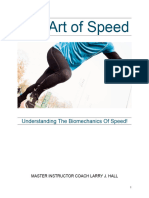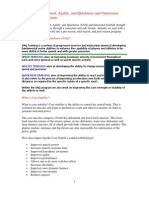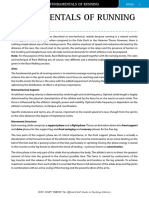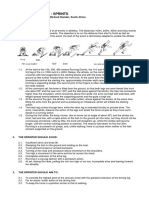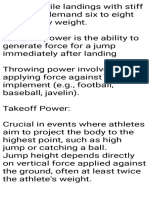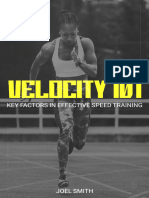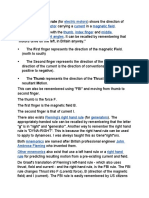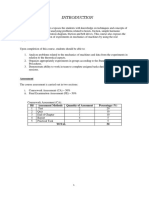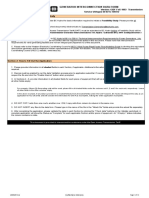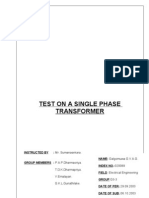Developing Speed
Kavitha Nambisan
Exercise Specialist
Strength and Conditioning Expert , SAI Bangaluru
� Learning Objectives
• What is speed?
• Factors affecting Speed.
• Understanding speed
• Determinants of running speed
• Running Gait
• Biomechanics of Speed
• Acceleration v/s max velocity
• Gravity
• Ground Contact Time
• Directional force application
• Optimal Force Development
• Key Elements of Speed Training/ training goal
• Annalysing before developing a sport specific program
• General Guidelines for speed programme
• Speed Drills
• References
�What is Speed?
• Speed—time taken to cover a specific distance.
• Speed requires the ability to accelerate and reach maximal velocity.
• Acceleration is the rate of change of velocity, or how quickly an
athlete can increase the velocity of the motion.
• Sports –
track- Linear direction
team - multidirectional.
• Gamespeed – application of speed in sport specific context, which
maximizes sport performance.
• Aspect such as – typical distance covered, duration to cover that
distance, signal that trigger movement, actions that will be carried
out when athlete reaches a given point varies from sport to sport.
�Factors affecting speed
• Genetic Limit- proportion fast twitch muscle fibers, ability to
recruit proportion of Type 2x fibers, athlete body type and
structure – lever lengths(arm and leg)- bone length and point
of muscle insertion, determine the capacity to move rapidly.
• Anaerobic capacity and lactate threshold.
• So, improving capacity and how it relates to sports, the nature
of running speed and identifying the elements that can be
enhanced through speed development program.
� Stride cadence and Stride
length.
• Running speed is determined by stride cadence and stride length.
• Stride cadence refers to the number of strides taken per second.
• Stride length refers to the distance traveled by each stride.
• Optimal stride length is targeted- if Stride length increases
athlete’s center of mass ahead – athlete’s force generation
capacity is less
• Stride Cadence is function of ground contact time and flight time –
focus on shortening ground contact time rather than cycling leg at
faster rate.
• Stride length is largely a function of the impulse and velocity
generated at toe-off.- focus on generating impulse and velocity
during the time the athlete is in contact with the ground.
��Running Gait
• The elastic energy generated in the early stance can
contribute to the force produced through the mid and late
stance.
• Velocity cannot be increased in flight phase.
• An inability to cycle the leg effectively results in suboptimal
ground contact on the next stance phase, and therefore limits
speed expression.
• Because athletes can propel themselves forward only when
their foot is in contact with the ground, the stance phase
should be the main focus of speed enhancement programs.
�Biomechanics of Speed
• Newton ‘s three laws are applicable-
• Law of inertia- every time athlete wants to start move or change direction ..
has to apply force(muscular).
• law of acceleration- the rate of change of motion (acceleration) is
proportional to the amount of force applied. Therefore ability to produce
force effectively and rapidly is essential.
• Amount of force depends on the athletic task or movement to be
performed.
• So training should be specific to each task to develop a range of movement
patterns.
• Strength training for speed development should focus on increasing force-
producing capacity not on increasing muscle size.
• Law of action and reaction -running forces are applied into the ground,
which then pushes the athlete upward and forward with an equal and
opposite force.
• Taking all of these laws together, it can be seen that ground forces largely
determine acceleration and running speed.
• Improving the application of ground forces needs to be a major focus of
any speed training program.
�Acceleration v/s Maximum
Velocity
• In the initial phase, an athlete’s velocity is low, and therefore
the capacity to increase velocity is great. This is the pure
acceleration phase, often referred to in track sprinting as the
drive phase- capacity to accelerate is higher.
• However as distance increases, athletes approach speeds far
closer to their maximum.
• Usain Bolt 10 meters he had only attained 73 percent Max
velocity. And at 30 meters had attained 93 percent Max
avelocity.
• As distance increases, the capacity for further acceleration
decreases.
• In the limits of court dimension in other sports, such as tennis
and basketball, acceleration may play a more important role
�Gravity
• sprinters also need to ensure that they exert sufficient vertical
force to overcome gravity and create sufficient time to
reposition their legs effectively for the successive stride.
• The direction of the net force, therefore, depends on body
position, the overall force the athlete applies, and the
muscles activated.
�Ground contact time
• Ground contact times are at their greatest during pure
acceleration (approximately .2 second), decrease through
transition acceleration (.12 second in late transition), and
decrease to .09 to .10 at maximum speed.
• During acceleration, greater ground contact times allow for
greater impulse, so force can be directed both vertically and
horizontally
�Ground contact time
• . Overall stride cadence is related closely to ground contact times,
and stride length is related to the impulse produced during ground
contact. Thus, a key element of speed may be the ability to
produce more force in a shorter time.
• This requires the development of appropriate strength and power
characteristics, including optimal stiffness and eccentric and
concentric force capacity.
• Earlier termination of the stance phase has been shown in both
acceleration and maximum-speed running- achieved by the
initiation of hip flexion before the completion of the stance.
• This requires high levels of stiffness in the knee and ankle to allow
for the rapid absorption of the eccentric landing forces, the
activation of the stretch-shortening cycle (SSC), and subsequent
concentric force production.
�Ground contact time
• The flight phase also plays an important preparatory role for
effective force production.
• At high velocities, athletes must reposition the swing leg
rapidly in order to prepare for the next stance phase.
• This rapid cycling action requires a triple flexion of the hip,
knee, and ankle, which results in shortening the lever and
allowing a rapid recovery cycle (cycling the leg through to the
next stance phase).
�Directional Force Application
• The horizontal and vertical aspects of force cannot be split,
therefore, the athlete needs to generate forces that reflect the
relative importance of each.
• In the initial acceleration, horizontal and vertical forces are
equally distributed, resulting in a forward lean at a 45-degree
angle.
��Optimal force devopment
• An athlete’s maximum-force capacity that determines running speed
but rather how much force can be applied in a given time- Ground
contact time is less
• Thus, speed depends on a capacity known as the rate of force
development.
• maximum force capacity has the biggest impact on initial
acceleration, while the rate of force development together with the
ability to store and use elastic energy (the stretch-shortening cycle)
play an increasingly important role as the distance of the run
increases.
• The development of maximum force, the rate of force
development, and the development of the stretch-shortening cycle
require different strength training interventions.
• During a sprint, forces are developed initially through the hips, then
the knee joint, and finally through the ankle joint. This movement is
known as triple extension.
�• Triple extension exercises such as the squat, Olympic lifts, and
hip extension exercises such as the Romanian deadlift.
� Optimal Force Development
• . During running, the initial ground contact results in a braking force, and the
athlete’s strength largely determines how well these forces are absorbed.
• The size of the braking force relates to the phase of the sprint and the speed
of the athlete.
• During a sprint, ground and muscle support forces can exceed bodyweight
by two and a half to five times, with the value increasing with increased
speed.
• Body needs to overcome this braking forces & produce propulsive forces to
continue accelerating or to maintain maximum speed.
• This propulsive forces are a combination of voluntary concentric forces and
reflexive, SSC-based forces.
• Springlike quality is maximized with greater stiffness, and increased
stability of the knee and ankle can optimize both reflexive force production
and ground contact times.
• The total force applied to the ground is enhanced by an effective arm action
in which the arm drives downward and backward.
• Stable and strong core can optimize force development, force transfer, and
force application.
� Sprinting Techniques
• Athletes need to learn how to assume effective postures and
how to use and coordinate arm and leg actions to maximize
ground force and stride cadence and, thus, maximize running
speed and acceleration.
• Effective technique maximizes stride effectiveness through
appropriate lever alignments and maximal efficiency, thus
conserving energy
� Key elements of Speed
Training / Training Goals
• Develop an athlete’s force production capacity in the musculature involved in
sprinting-
• Maximal force capacity
• Rate of force development
• Stretch-shortening cycle ability
• In the strength and conditioning setting, weightlifting movements and their
derivatives such as the clean, snatch, and midthigh pulls may enhance sprint
performance through physiological adaptations such as muscular stiffness,
enhanced RFD, and coactivation of the musculature surroundingthe hips
and knees.
• Similarly,upright sprinting uses the SSC, defining it as a plyometric
movement.
• Chronic exposure to movements eliciting the SSC can increase muscle
stiffness, which is a potential physiological advantage for sprint ability.
• Sprinting requires near-maximum to maximum muscle activation, which
depends on high central nervous system activity. This activity often referred as
rate coding in an effort to either enhance the force required or target potential
neuromuscular adaptations for sprinting improvement, resisted and assisted
sprint training techniques are often employed
�• Technical training targets areas of deficiency in the running action.
This form of training starts with an analysis of performance and then
addresses areas of deficiency such as arm action, leg action, and so
on.
• Application of speed:- ability to effectively transfer speed to
enhance gamespeed . A speed improvement program must involve
speed application and address all of the elements that affect
performance in a particular sport, such as initial acceleration,
transition acceleration, and maximum speed.
• Mobility- an athlete may possess the physical characteristics
necessary to yield high rates of force in a short amount of time, but
compromises in a joint’s freedom of movement will result in
misplaced force.
• Emphasize brief ground support times as a means of achieving
rapid stride rate.
• Emphasize the further development of the SSC as a means to
increase the amplitude of impulse for each step of the sprint.
�General Guideline for speed
programme
• All speed workout should only proceed when fully recovered from
previous session.
• It is most effective at beginning of training sesssion
• Proper sprinting technique must be taught and mastered through
several perfect drill sessions over long period of time.
• All sets and reps must accompany proper rest. Athlete’s HR & RR
should come back to normal from previous drill.
• One to four work to rest ratio is recommended.
• Speed workout should vary as light medium and heavy days. For
adequate recovery.
• To achieve maximum speed, athlete must learn to run in a relaxed
manner while at the same time exerting maximum effort.
• Speed Endurance can be accomplished by running longer intervals –
165 to 440 yards(151 – 402 m) or by decreasing the rest b/w short short
intervals to b/w 20 to 65 yards(18 m and 49 m). Later being good
choice for sport specific applications.
• All speed workout must precede with dynamic warm up & flexibility
routine.
�Develop a sport specific speed programme
following question should be addresed
• What distances are typically run?
• In what direction does movement typically occur?
• What are the typical starting methods?
• What are the typical movement combinations?
• What stimuli trigger and control movement?
• How does speed relate to sort-specific skills and
requirements?
�Foot ball sport specific drills
• Acceleration Drills
• Wall drive
• Lateral Ball Drop
• Multidirectional rolling start
• Change in direction skill
• Side shuffle and Cut
• Run to space
• Soccer specific curved running
• Get past (defender moving backward)
• Maximum Speed Drills
• Acceleration run
• Ins and out
• Deceleration Drills
• Decelerate to staggered specific stance
• Decelerate to a skill
�Strength Training recommendation
���Speed Drills
������������������������References
• Developing Speed by NSCA
• Essential of strength and conditioning manual NSCA
• Training for Speed , Agility and Quickness by Lee E Brown

















